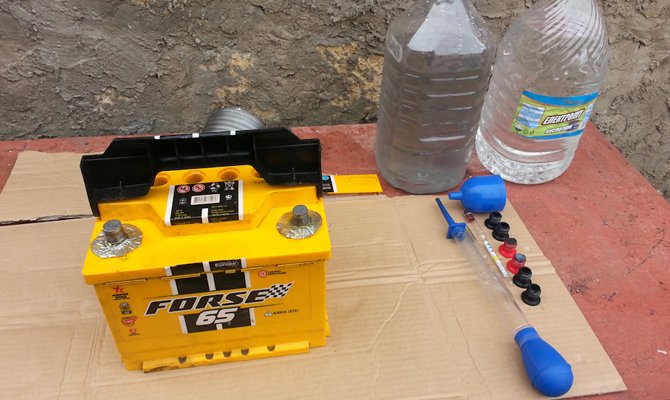Battery health is one of the main conditions for trouble-free operation of the car. There are cases, especially in winter, when the battery capacity drops sharply, and the owner has to run for the new battery to the store. Such expenses are not always justified. If the battery is not older than 5 years, then you can try to restore it with a complete replacement of the electrolyte.
Content
Is it possible to change the electrolyte in the battery
Disputes in this regard still go. It is not difficult to replace the electrolyte in the battery, although there are some features. With proper dexterity, you can change the solution yourself even in a maintenance-free battery.
Some claim that the replacement will not give the desired result, and the battery will last only a couple of additional months. Others note that the method is effective and the battery after replacement will last from a year to two with the correct procedure. In any case, it’s worth a try, because the cost of the electrolyte is incomparable with the price of a new battery.
Reasons for a complete electrolyte replacement
It is important to understand that far from all cases a complete electrolyte replacement helps. Before proceeding to the procedure, it is worth examining the reasons requiring a solution replacement:
- Density has changed. An indirect sign of a change in density may be the uncharacteristic color of the solution. A density meter should be used to check density. Before measuring, you need to fully charge the battery. The density of the solution in a normal battery should be between 1.25 and 1.27 g / cm3.
- Turbidity of electrolyte. Such changes are observed with poor-quality solution, which was diluted with ordinary rather than distilled water. Also the reason may be plate sulphation.
- A new battery quickly loses its charge (up to a full discharge within a day). This is usually due to an insufficient concentration of sulfuric acid in the solution.
- One of the cells does not contain a solution.
- The electrolyte was susceptible to freezing.
- Part of the solution evaporated due to poor sealing (observed with serviced battery models).
Important! If the battery plates are crumbled or there is a short circuit on one of the cells, then replacing the solution will not help. In this case, the restoration of performance is possible only after replacing the package of plates in the cell. This is a rather complicated procedure and requires special equipment.
Precautionary measures
In the process of working with electrolyte and putting the battery on charge, you need to use rubber gloves, a protective apron, glasses and shoes that are resistant to acids.
The room should be well ventilated. It is forbidden to store or take food in it. It is also not allowed to smoke near the solution, since hydrogen vapors can easily ignite.
Pour the solution necessary using glassware. Sulfuric acid contained in the solution, even at low concentrations, burns clothes and causes chemical burns.
Important! If electrolyte gets on clothing or skin, an immediate rinse with plenty of water is required. After, the acid must be neutralized with baking soda.
How to replace the electrolyte in the battery yourself
During the replacement process, completely drain the liquid from all the battery cells and flush with distilled water.
It is recommended to drain the solution from the bottom of the battery to prevent it from turning over. This should be avoided so that the sediment does not rise and close the bag in the cell. Carefully drill a 3mm hole in the bottom of the battery. The volume of the drained liquid is on average 2 liters.After the flushing is completed, it is necessary to seal the drilled holes.
Only acid-resistant plastic or sealant should be used for sealing. A part of the housing of an unusable battery or its plug is suitable. After sealing, fill in fresh electrolyte with a density of 1.27-1.28 g / cm3 and carry out the charging procedure.
How to charge the battery after replacing the electrolyte
After filling the battery, you need to wait 2 to 5 hours until the end of the reaction and density stabilization. Standby time depends on capacity. It should be charged with a current of no more than 2 A in the automatic charger mode. After charging is complete, the battery will be ready for use.
The method is available to almost everyone, but it is worthwhile to understand that a battery after such resuscitation cannot replace a new one. This method should be used to make time for buying a battery. It is important to remember that the complete discharge of the restored battery will lead to deep sulfation, resuscitation after which will be impossible.
There are questions about how change electrolyte or have something to add? Then write to us about it in the comments, this will make the material more useful, complete and accurate.









